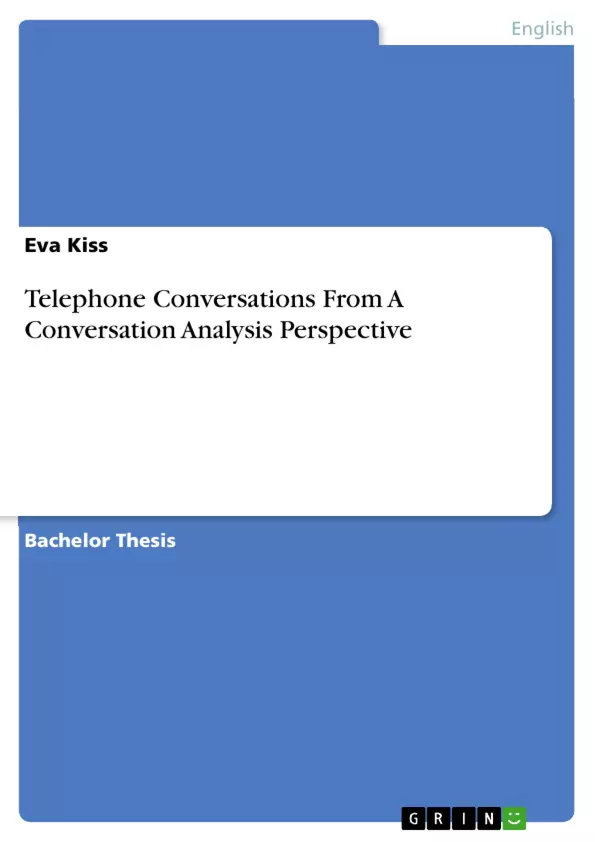
Telephone Conversations From A Conversation Analysis Perspective
Bachelorarbeit, 2003
35 Seiten, Note: 2,7 (B-)
Leseprobe
Table of Contents
- I. INTRODUCTION
- II. TELEPHONE CONVERSATION FROM A CONVERSATION ANALYSIS PERSPECTIVE.
- 1. CONVERSATIONAL BASICS.
- 1.1. Conversation Analysis versus Discourse Analysis.
- 1.2 Conversation.
- 1.2.1 Definition of Conversation.
- 1.2.2 Turn-taking.
- 1.2.3 Adjacency Pairs.
- 1.2.4 Preference Organization.
- 1.2.5 Problems in Conversations.
- 2. TELEPHONE CONVERSATION
- 2.1. Basics
- 2.2 Openings
- 2.2.1 Summons-Answer.
- 2.2.2 Identification and Recognition.
- 2.2.4 Opening Structure...
- 2.3 Topic talk..
- 2.4 Closings.
- 2.4.1 Terminal Exchange and Pre-closing..
- 2.4.2 Closing Components and Re-opening
- 2.4.3 Special Closings.
- 3. MOBILE TELEPHONE CONVERSATION
- 3.1 Basics
- 3.2 Openings
- 3.3 Topic-talk.
- 3.4 Closings....
- III. CONCLUSION.
Objectives and Key Themes
This paper aims to examine the mechanisms of telephone conversation and how these systems have changed since the introduction of the mobile telephone. The paper focuses on the research methodology of Conversation Analysis to explore the basic features of conversation, followed by an examination of telephone conversations in terms of their opening, topic-talk, and closing structures. Finally, the paper highlights changes in this structure for mobile telephone conversations.
- The impact of technological advancements on communication patterns
- The application of Conversation Analysis in examining telephone interactions
- The structure and organization of telephone conversations
- The differences and similarities between traditional and mobile telephone conversations
- The influence of social and cultural context on conversational patterns
Chapter Summaries
The introduction sets the context for the paper by discussing the ubiquity of conversation and highlighting the need for a deeper understanding of its structure and organization. It introduces Conversation Analysis as the chosen research methodology and outlines the paper's structure.
Chapter II delves into the core concepts of Conversation Analysis, contrasting it with Discourse Analysis. It explores the basic features of conversation, including turn-taking, adjacency pairs, preference organization, and common problems encountered in conversations. This section provides a theoretical framework for understanding the structure of telephone conversations.
Chapter II then focuses specifically on telephone conversations, examining their opening sequences, topic-talk, and closing strategies. It explores the role of summons-answer sequences, identification and recognition, and various opening structures. The chapter also discusses the mechanics of closing conversations, including terminal exchanges, pre-closings, closing components, re-opening, and special closing practices.
Chapter III examines the unique characteristics of mobile telephone conversations, focusing on their openings, topic-talk, and closings. It explores how the introduction of mobile technology has influenced conversational practices and how these practices differ from traditional telephone conversations.
Keywords
The paper centers on the study of communication, specifically focusing on telephone conversations, Conversation Analysis, discourse analysis, turn-taking, adjacency pairs, opening and closing structures, and mobile phone conversations.
Details
- Titel
- Telephone Conversations From A Conversation Analysis Perspective
- Hochschule
- Universität Bayreuth (Language and Literature Sciences)
- Note
- 2,7 (B-)
- Autor
- Eva Kiss (Autor:in)
- Erscheinungsjahr
- 2003
- Seiten
- 35
- Katalognummer
- V30746
- ISBN (eBook)
- 9783638319409
- Dateigröße
- 601 KB
- Sprache
- Englisch
- Anmerkungen
- Schlagworte
- Telephone Conversations From Conversation Analysis Perspective
- Produktsicherheit
- GRIN Publishing GmbH
- Preis (Ebook)
- US$ 17,99
- Arbeit zitieren
- Eva Kiss (Autor:in), 2003, Telephone Conversations From A Conversation Analysis Perspective, München, Page::Imprint:: GRINVerlagOHG, https://www.diplomarbeiten24.de/document/30746
- Autor werden
- Ihre Optionen
- Vertriebskanäle
- Premium Services
- Autorenprofil
- Textarten und Formate
- Services für Verlage, Hochschulen, Unternehmen

- © GRIN Publishing GmbH.
- Alle Inhalte urheberrechtlich geschützt. Kopieren und verbreiten untersagt.
- info@grin.com
- AGB
- Open Publishing
Der GRIN Verlag hat sich seit 1998 auf die Veröffentlichung akademischer eBooks und Bücher spezialisiert. Der GRIN Verlag steht damit als erstes Unternehmen für User Generated Quality Content. Die Verlagsseiten GRIN.com, Hausarbeiten.de und Diplomarbeiten24 bieten für Hochschullehrer, Absolventen und Studenten die ideale Plattform, wissenschaftliche Texte wie Hausarbeiten, Referate, Bachelorarbeiten, Masterarbeiten, Diplomarbeiten, Dissertationen und wissenschaftliche Aufsätze einem breiten Publikum zu präsentieren.
Kostenfreie Veröffentlichung: Hausarbeit, Bachelorarbeit, Diplomarbeit, Dissertation, Masterarbeit, Interpretation oder Referat jetzt veröffentlichen!
- GRIN Verlag GmbH
-
- Nymphenburger Str. 86
- 80636
- Munich, Deutschland
- +49 89-550559-0
- +49 89-550559-10
- info@grin.com
-









